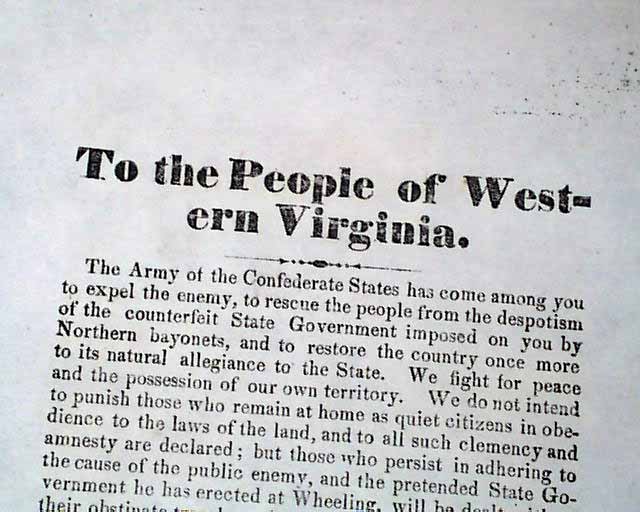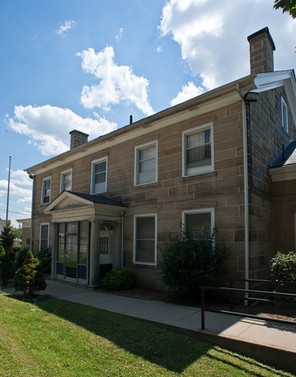Littlepage Mansion-Charleston Civil War Trail
Introduction
Author-Uploaded Audio
Listen to a narration of this entry's description by Eliza Kolander.
Text-to-speech Audio
Images
A notice hung by Confederates in the city of Charleston shortly after their arrival.

This stone home was built in 1845 and is most famous for Rebecca Littlepage's refusal to yield to Confederate General Henry Wise.

Backstory and Context
Author-Uploaded Audio
Listen to a narration of this entry's description by Eliza Kolander.
Text-to-speech Audio
The "Stone House" was built in 1845 by Harop L. Joy and J. Carson. Designed in simple Federal style, the sandstone for the spacious and well-proportioned home was quarried on the property. An important West Virginia woman lived much of her life in the house, and it is her story that echoes throughout the home today.
Rebecca Wood was born in March 1824 to prosperous landowning parents in the Kanawha Valley. She quickly grew into a strong, intelligent, and spunky young woman, and was married to Adam Littlepage, who had recently (on February 8, 1845) moved to the Kanawha Valley to join the growing salt business. The recently married Littlepages moved to a rented home near Brook’s Furnace, located on the site of what is now Daniel Boone Park. There, Rebecca and Adam welcomed their first three children, daughters Mary Lavinia and Mary Elizabeth and son John William. Both of the girls died in infancy, a common occurrence in those times.
In 1848, the young couple began to plan for a permanent home when the Stone House on Kanawha Two-Mile Creek went up for auction. Adam Littlepage outbid Dr. Spicer Patrick, who owned adjacent property, by $500, and Rebecca Littlepage moved into the Stone House, which was to be her home for the rest of her life, with her family.
The Littlepage family quickly grew; Rebecca brought five more children into the world before the outbreak of the Civil War in 1861.
Unlike the rest of Western Virginia, Kanawha County had a sizable slave population. In 1850, there were more than 3,000 slaves compared to a free population of 12,000. Rebecca’s mother had given her a slave, a young woman of 18 named Celine, at the time of Rebecca’s marriage to Adam Littlepage. Adam, an industrious businessman, used slaves in one of his many businesses, a cooperage across the street from the Stone House.
When the state of Virginia seceded from the Union, the Kanawha Valley was sharply divided. Like the Littlepages, many of the landed gentry were supporters of the Southern cause. The top command post for the Kanawha Valley was controversially given to Henry A. Wise, former governor of Virginia. Wise was soon sent to the Valley to protect it from an invasion that might come from Union troops in Ohio. Wise and his soldiers set up camp near one of Adam Littlepage’s landholdings, a farm that was the main source of the family's food. While the Confederate troops camper near their property, they helped themselves to grain, horses, bacon, molasses, and sugar.
Wise and Adam Littlepage soon butted heads over the fact that Littlepage continued to operate his cooperage business and his general store instead of joining the Confederate troops. Wise called Adam a “Yankee sympathizer who must be taught a lesson,” and demanded that he join the army or his property would be confiscated. He announced that he intended to use the Stone House as his headquarters.
General Wise soon presented himself confidently as the door of the Stone House. It was Rebecca Littlepage who came to the door. Upon hearing Wise’s demands that the home be his headquarters, Rebecca (showing no sign of trepidation) told him that the the house was as much hers and it was her husband’s, and that she would not allow him to enter. Wise left with a threat to “blow the house down over your head.”
The general returned later with artillery. A crowd of spectators gathered to watch. As tent poles were put in the ground of the front lawn, Rebecca went around and kicked them down. And as the guns were being wheeling into position, she gathered her children around her on the front steps. Wise gave her two minutes to remove herself and her children, an order that she ignored. An enraged Wise gave the order to open fire, but the captain refused. An enraged Wise marched off, never to return to the Littlepage house.
Despite his responsibilities at home, Adam Littlepage soon entered the military on the Confederate side as the quartermaster officer of the Twenty-Second Infantry under George S. Patton’s command. Rebecca and Adam’s seventh child, a girl, was born after Adam left home. Never to return home, Littlepage died in a duel over a saddle. His opponent was also mortally wounded.
Rebecca was left a widow with seven children. As the tide of war shifted, her situation become desperate and she relied on her courage and ingenuity to protect herself and her family. During the years of the war, sentries of one army or another were constantly present on Rebecca Littlepage’s property. She fed the soldiers and recognized that it made sense to put away her partisan feelings.
After the war, Rebecca was forced to sell some of Adam’s landholdings to pay the taxes on the Stone House. The Littlepage children were taught by a governess who lived in the house, which soon became known as the “Stone Mansion.”
When Rebecca died, in 1896 of pneumonia, a giant acorn (carved of the same sandstone as the Stone House) was erected on her grave. The unique marker evokes the memory of a strong-willed, independent woman.
Sources
Sherwood, D., & Hartman, J. (1986). Rebecca Tendael Wood Littlepage. In F. Hensley (Ed.), Missing Chapters II: West Virginia Women in History (pp. 100–116)
